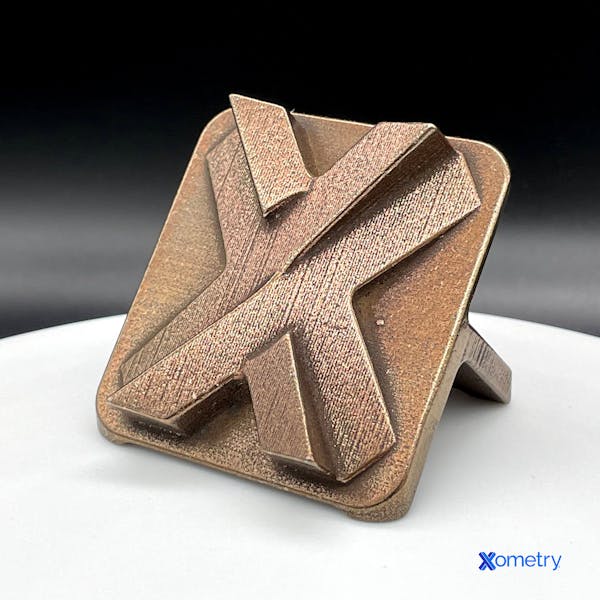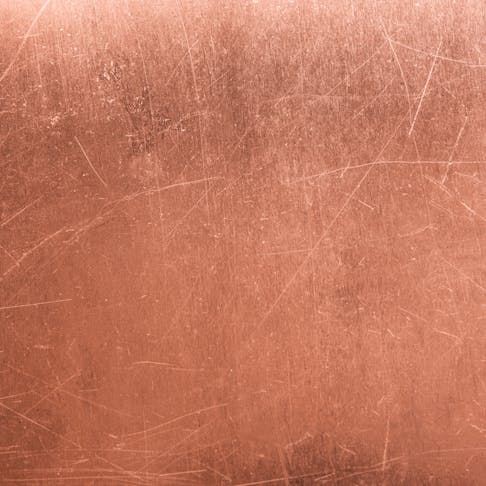Bronze isn’t all foam and no beer—it’s just as useful as it is pretty. You’ve surely seen it in the form of door handles, medals, and ornaments (you may even have some of these in your home), but those are certainly not all it’s good for. Engine parts, tools, and pumps are made from bronze, too (okay, and some other fun things like ship’s bells, fountains, and propellers). Read on to learn more about it, and how you can use it for your own manufacturing needs.
What is Bronze?
Bronze is a reddish-brown metal alloy in the “red metal” family made up of 88% copper, and 12% tin. It’s malleable (but harder than copper) so it’s easy to manufacture into different products and has low metal-to-metal friction. It also forms a natural protective layer (patina) on its surface that keeps it corrosion-resistant. Depending on what properties are needed, it’s sometimes mixed with other elements like phosphorus, silicone, or zinc. It’s made using the bronze casting process where it’s melted and mixed with whatever other elements needed, poured it into molds, and allowed to cool and harden. Here’s a cool object (if we do say so ourselves) we 3D printed with bronze:

Different Types of Bronze
There are so many different bronze alloy types (around 50, give or take) that if we were to go through all of them, we’d be here all day. We wrote an article about nine of them, and for ease of reference, we’ll list the five most common types used in manufacturing below, with the amounts of the other elements (in addition to copper) they contain.
| Bronze Type | Composition (in addition to copper) |
|---|---|
Bronze Type Aluminum bronze | Composition (in addition to copper) 6–12% aluminum |
Bronze Type Nickel aluminum bronze | Composition (in addition to copper) 6–13% aluminum, up to 7% iron, and 7% nickel |
Bronze Type Silicon bronze | Composition (in addition to copper) Up to 6% silicon |
Bronze Type Phosphor bronze (or tin bronze) | Composition (in addition to copper) Up to 11% tin and up to 0.35% phosphorus |
Bronze Type Manganese bronze | Composition (in addition to copper) Up to 3% manganese |
Different Types of Bronze Composition
Properties
In the following two sections, we’ll break down both the physical and chemical properties of bronze, helping you understand the metal a little better.
| Property | Description |
|---|---|
Property Density (g/cc) | Description 5.60 - 9.30 |
Property Color | Description Reddish-brown metallic color |
Property Melting point (°C) | Description 315 - 1180 |
Property Boiling Point (°C) | Description 1400 |
Property Thermal Conductivity (W/m-K ) | Description 1.01 - 208 |
Physical Properties of Bronze. Table Credit: https://www.matweb.com/search/DataSheet.aspx?MatGUID=66575ff2cd5249c49d76df15b47dbca4&ckck=1
Now, let’s take a look at bronze’s chemical properties:
| Property | Description |
|---|---|
Property Corrosion resistance | Description Good |
Property Electrical and thermal conductivity | Description Good |
Property Oxidation products | Description copper oxide and copper carbonate (green patina) |
Property Magnetic | Description No |
Property Malleability | Description Good |
Property Ductility | Description High |
Chemical Properties of Bronze
| Tools | Bronze was being made into tools and weapons from as early as the Bronze Age (only around 5,000 years ago). Our ancestors were obviously onto something because it’s still being used today to make the same things, including hammers, wrenches, chisels, blades, gears, and bearings. |
|---|---|
Tools Architecture | Bronze was being made into tools and weapons from as early as the Bronze Age (only around 5,000 years ago). Our ancestors were obviously onto something because it’s still being used today to make the same things, including hammers, wrenches, chisels, blades, gears, and bearings. Architects particularly love bronze as it’s a snazzy addition to any building, offering decorative flair, as well as strength and durability. It’s made into door or window frames, cabinet handles, or trims. Bronze used for architectural purposes is often more natural in color, but if it’s used outside (sculptures or ornaments) it’s usually patinized. |
Tools Coins | Bronze was being made into tools and weapons from as early as the Bronze Age (only around 5,000 years ago). Our ancestors were obviously onto something because it’s still being used today to make the same things, including hammers, wrenches, chisels, blades, gears, and bearings. Back in ancient times, bronze was one of the two main metals for coins, alongside copper. Modern coins, though, have replaced them with metals like copper-plated steel, zinc, and nickel, mainly for pricing reasons. |
Tools Instruments | Bronze was being made into tools and weapons from as early as the Bronze Age (only around 5,000 years ago). Our ancestors were obviously onto something because it’s still being used today to make the same things, including hammers, wrenches, chisels, blades, gears, and bearings. Cymbals, bells, gongs, and a host of other musical instruments can be made from bronze. They’re cast in a very interesting formulation called “bell metal.” Other types of bronze like phosphor bronze are sometimes used to make acoustic guitar and piano strings, too. |
Tools Bells | Bronze was being made into tools and weapons from as early as the Bronze Age (only around 5,000 years ago). Our ancestors were obviously onto something because it’s still being used today to make the same things, including hammers, wrenches, chisels, blades, gears, and bearings. Bronze can produce a strong and clear tone, hence it’s used to make bells. Like with musical instruments, bells are made from the same “bell metal” which is basically made from 80% copper and 20% tin—a balance that creates very nice sounds and resonance by absorbing energy. |
Tools Bearings | Bronze was being made into tools and weapons from as early as the Bronze Age (only around 5,000 years ago). Our ancestors were obviously onto something because it’s still being used today to make the same things, including hammers, wrenches, chisels, blades, gears, and bearings. Bronze, in a formulation called “bearing bronze” which is strong and hard, is great for making things like springs, bearings, and bushings, especially when it comes to car transmissions and small electric motors. These types of bearings are usually shock-, impact-, wear-, and corrosion-resistant, and used in sectors like food processing, injection molding, and automotive equipment. |
Tools Medals | Bronze was being made into tools and weapons from as early as the Bronze Age (only around 5,000 years ago). Our ancestors were obviously onto something because it’s still being used today to make the same things, including hammers, wrenches, chisels, blades, gears, and bearings. Most of us will have first heard of bronze at an early age thanks to the “bronze medal” won in sporting events and other competitions. Before the 1904 Summer Olympics in St. Louis, MO, silver medals were given to winners, and bronze was awarded to the runners-up. Then gold entered the scene and our beloved bronze got relegated to third place. |
Bronze Applications
| Advantages | Disadvantages |
|---|---|
Advantages It’s much harder than pure copper or iron | Disadvantages Its hardness might make it more difficult to work with |
Advantages It has better corrosion resistance, heat and electrical conductivity, and fatigue-resistance than most steels | Disadvantages It tends to oxidize more easily than copper does |
Advantages It’s easier to cast than copper because it’s more fusible | Disadvantages It’s often more expensive than steel, brass, or copper |
Advantages It has low metal-to-metal friction | Disadvantages Its kryptonite is ferric compounds, ammonia, and cyanides—sulfur and chlorine can actually cause it to deteriorate in humid environments |
Advantages It’s both versatile and durable | Disadvantages As odd as it sounds, bronze can get sick. Bronze Disease (yes, this is a real thing) makes small, rough, pale green spots suddenly appear on its surface when oxygen and chloride react in water. Left unchecked, it could be totally destroyed. |
Advantages It has a good surface finish |
Bronze Pros and Cons
Bronze vs. Brass
Xometry customers often ask us about the difference between these two metals when they need a nice-looking metal for their manufacturing needs. It mainly comes down to their composition and properties. Both are copper alloys and corrosion resistant, but bronze can make itself a protective patina, whereas brass will tarnish over time. Brass is made of copper, zinc, and other elements that contribute to its color, which can be bright gold, copper, or silver. It’s more malleable than bronze, which means you don’t have to worry about it breaking when hammered or rolled (within reason, of course).
How Xometry Can Help
Xometry provides a wide range of manufacturing capabilities, including 3D printing, laser cutting, CNC machining, and much more. If you want to learn more about bronze, brass, or any other type of metal, or request a free no-obligation quote, reach out to a Xometry representative today.
Disclaimer
The content appearing on this webpage is for informational purposes only. Xometry makes no representation or warranty of any kind, be it expressed or implied, as to the accuracy, completeness, or validity of the information. Any performance parameters, geometric tolerances, specific design features, quality and types of materials, or processes should not be inferred to represent what will be delivered by third-party suppliers or manufacturers through Xometry’s network. Buyers seeking quotes for parts are responsible for defining the specific requirements for those parts. Please refer to our terms and conditions for more information.


